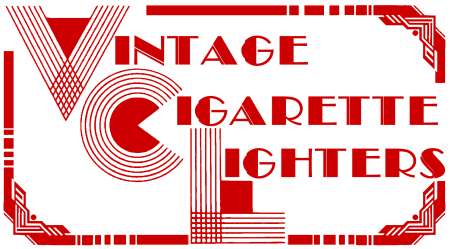Beattie Jet Lighters
Beattie Jet Lighters were made from the mid-1940s until 1961.
The jet lighter was first invented by London-based Guy S. Barker in 1929. He filed his U.S. Patent on November 5th, 1930 and was granted his patent on January 17th, 1933. Inventor William E. Evans, who worked for the Waterbury Lock and Specialty Company of Milford Connecticut, created a refined design based on Barker’s original work. Evans filed his patent on August 25, 1939 and was granted a patent on May 20, 1941. Yet a third jet lighter design was created by Francis Leslie Phillips who received his patent approval on December 30, 1947. Phillips design is almost an exact duplicate of Evans’ earlier design.
It is possible to differentiate earlier Beattie Jet lighters from later versions by both the patent number(s) listed on the lighter and by the typography engraved onto the lighters’ bottoms. Earlier lighters list Guy Barker’s patent number: 1894300
Later versions list both the Evans patent number (2242906) and the Phillips patent number (2433707). Oddly, some Phillips-designed lighters with a reservoir fill screw on the bottom list the Barker patent number and not the Phillips number.
Sometime prior to 1944, the patent rights to manufacture the Beattie Jet lighter were acquired by Robert W. Beattie of Brooklyn New York. Beattie, who grew up in Upstate New York in the Long Lake area attended the Manual Training High School, an engineering and technical school where he developed an appreciation for ingenuity in invention. Though the Beatties lived in Brooklyn where they operated a pre-school, Beattie and his wife, Elvira, owned and operated a summer camp – Camp Beattie - located on the west shore of Long Lake. The camp is no longer in operation; it has become a private residence. Robert Beattie was also apparently an early marketer and/or distributor for the original Jet lighter made in England.
The Beattie Jet Lighter was produced in nickel plate, chrome plate, engine-turned chrome, heavy silver plate, heavy gold plate, and in solid sterling silver. One could buy them encased in lizard, morocco, and pig skin leathers. Prices ranged from $6.95 to $49.00 for the solid sterling models. A desk model in either morocco or pigskin was sold for $11.95.
Champ also produced the Champ Jet Stream lighter (c. 1950) which was essentially the same, as did Lord Chesterfield (c. 1955) and MasterCraft Spit Fire (c. 1955). Rogers produced the Rocket Flame Lighter in Japan (c. 1958). The Jet lighter, made in England and marketed by Robert Beattie, was probably the oldest - patented in 1929.
PRIMARY SOURCE: http://www.apassionforpipes.com/neills-blog/2011/4/5/the-amazing-beattie-jet-lighter.html
|

